Exercises (3201)
Passive stretching: calf muscles
Stretching
Partner work

Lunge towards your partner. With your arms stretched out, press your palms against your partner's and press the heel of your back leg to the floor. Then switch legs.
No material required
Passive stretching: calf muscles
Stretching
Partner work

Stand hip-width apart opposite your partner, tilt your upper body forwards and press your palms against your partner's with your arms stretched out overhead (holding them up). Press your heels to the floor.
No material required
Passive stretching: calf muscles
Stretching
Individual work
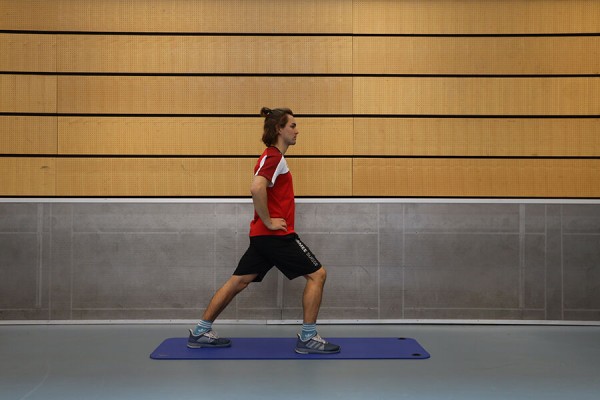
In a stepping position, place both feet flat on the floor (front leg bent, back leg extended - press the heel of the back leg against the floor), lean the upper body forwards. The stretch can be intensified with a larger support. Then switch legs.
No material required
Passive stretching: calf muscles
Stretching
Individual work

From a shortened stride position, bend the back leg forwards at the knee joint so that the knee protrudes over the tip of the foot (the tilt creates a stretch in the lower calf of the back bent leg - heels always remain on the floor). Then switch sides.
No material required
Passive stretching: calf muscles
Stretching
Individual work

With the leg slightly bent, place the toe of the foot on a small elevation (e.g. step) and press the heel down. The supporting leg is either also placed on the elevation (better option) or underneath the elevation on the surface. Then switch sides.
No material required
Passive stretching: calf muscles
Stretching
Partner work





Stand hip-width apart opposite your partner, tilt your upper body forwards and press your palms against the aid with your arms stretched out overhead (holding them up) (clamp the object together). Press your heels onto the floor.
Per group of 2:
1 ball ►baseball, blitzball/rugby/football, fistball, futsal/football, handball, FooBaSKILL, volleyball
1 stick ► floorball, intercrosse/lacrosse, Nordic walking
1 racket ►badminton/speedminton, smolball
1 throwing disc (frisbee) ►frisbee ultimate
1 elasticated rubber band/power tube/skipping rope/playing rope
1 gymnastics stick with elastic band
Passive stretching: calf muscles
Stretching
Partner work





Lunge towards your partner. With outstretched arms, press the palms of your hands against the aid (pinch the object together) and press the heel of the back leg to the floor. Then switch legs.
Per group of 2:
1 ball ►baseball, blitzball/rugby/football, fistball, futsal/football, handball, FooBaSKILL, volleyball
1 stick ► floorball, intercrosse/lacrosse, Nordic walking
1 racket ►badminton/speedminton, smolball
1 throwing disc (frisbee) ►frisbee ultimate
1 elasticated rubber band/power tube/skipping rope/playing rope
1 gymnastics stick with elastic band
Passport collector
Forms of play / exercises
Group work
2 teams
Exercise description:
Two teams play against each other in a predetermined field. The aim is to play as many passes as possible within the team before an opponent can intercept the ball/throwing disc or the ball/throwing disc falls to the ground. If the pass attempt is intercepted or the ball/throwing disc falls to the ground, the right to pass the ball/disc changes hands and the other team now tries to collect as many successful passes as possible. Optional additional rule for more intensity: If a player in possession of the ball/disc is touched by a defender, he must immediately (within 2-3 seconds) play a pass, otherwise the right to attack also changes. Which team has achieved the most passes after a certain time?
Variant:
10 passes in a row result in one point, after which the right to the ball/disc changes.
1 ball/throwing disc ►Basketball, Blitzball/Touchrugby, Frisbee Ultimate, FooBaSKILL, Futsal/Football, Handball, Intercross/Lacrosse, Smolball, Tchoukball, Floorball
4 marking cones/caps (optional) ►Field markings
x playing ribbons/bibs ►Team identification
Pro Tn:
1 stick ►intercross/lacrosse, floorball
1 stick ►smolball
Passing game
Coordination exercises
Partner work

Two participants stand opposite each other on the thin side of a long bench at a distance of approx. 4-5 metres and play badminton (or Indiaca).
► Differentiation ability, orientation ability
Per group of 2:
2 badminton rackets
1 badminton shuttle
1 Indiaca
2 long benches
Post setup:
Place two long benches parallel to each other with a distance of approx. 4-5 metres and the narrow side facing upwards.
Passing game
Coordination exercises
Partner work
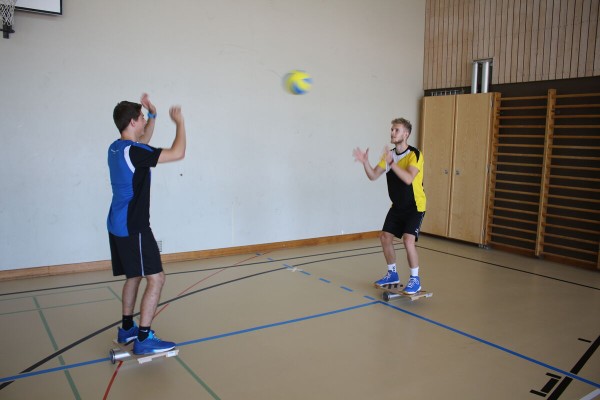
The participants stand approx. 3 metres apart and throw a volleyball at each other. Both participants stand on a medicine ball or a balance board and try to keep their balance. If the exercise is too difficult, the participants can support each other (hold/secure) and first try to stand reasonably safely on the medicine ball/balance board.
► Balance skills
2 balance boards/medicine balls
1 volleyball
Passing game
Coordination exercises
Partner work
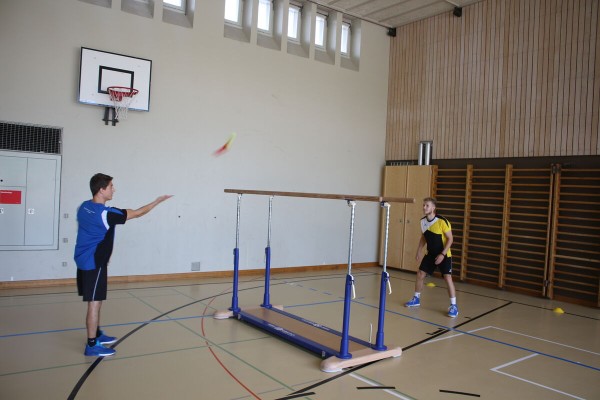
The participants pass an Indiaca to each other with the palms of their hands over the raised bar. They try to play right and left and keep the Indiaca in the air for as long as possible.
Variant:
Game (competition) for points.
► Differentiation ability, reaction ability
1 parallel bar
1 Indiaca
4 marking cones (optional) ►Playing field marking
Post set-up:
Fix the uprights of a parallel bar at a great height. Optionally mark a playing field around the bar using cones
Passing game
Coordination exercises
Partner work
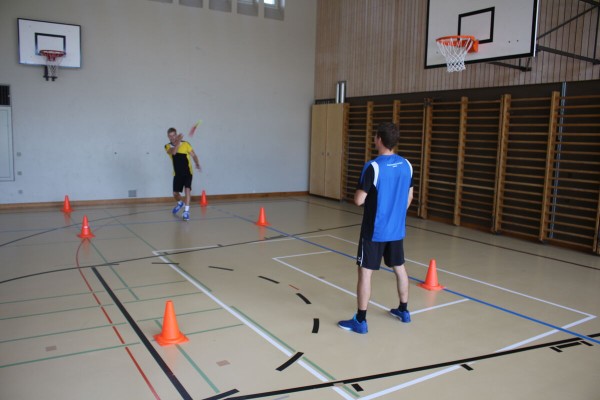
The participants stand opposite each other in two marked rectangles with a certain distance between the fields (approx. 4-5 metres for Indiaca/badminton; approx. 8-10 metres for speedminton). The participants play an Indiaca with the palms of their hands or a shuttle with their rackets. When playing with the Indiaca, participants try to play with the right and left. The aim is to keep the Indiaca/shuttle in the air for as long as possible.
Variant:
Game (competition) for points.
► Differentiation ability, reaction ability
8 marker cones/cups
1 Indiaca
Post set-up:
Mark out two playing fields using cones.
Passing game
Coordination exercises
Partner work
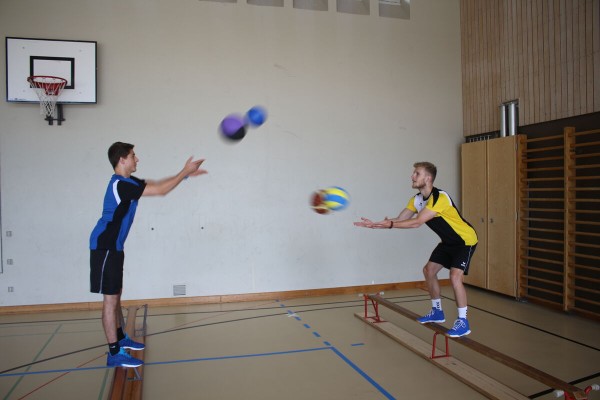
Two participants stand opposite each other on the narrow side of a long bench and pass two different balls to each other at the same time.
Variation:
Plays via the floor.
► Balance skills, differentiation skills
2 long benches
1 football
1 volleyball
1 softball
1 floorball
1 tennis ball
1 medicine ball
1 handball
1 lightning ball
Post setup:
Place two long benches parallel to each other with a distance of approx. 2-3 metres between them.
Passing game
Coordination exercises
Partner work
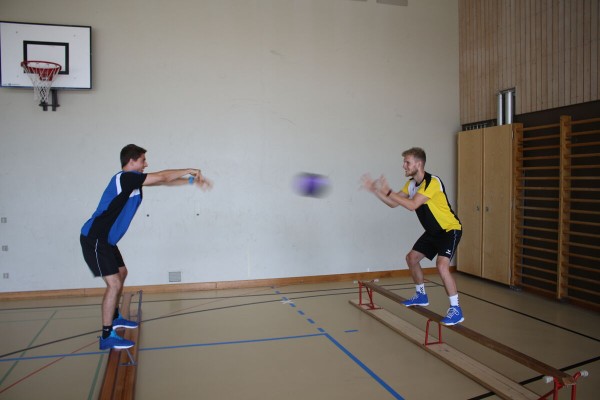
Two participants stand opposite each other on the narrow side of a long bench and try to unbalance their partner by throwing a medicine ball at them so that they have to leave the bench when they catch the ball.
► Balance skills
2 long benches
1 medicine ball
Post set-up:
Place two long benches parallel to each other at a distance of approx. 2-3 metres.
Break / postponement
Miscellaneous
Participants are given a break after each station. The recovery time is also used to move to the next station/post.
Pebble walk
Power
Individual work

Place 3 small stones on the floor; balance on two of these stones. Move the third free stone; switch to this stone with one foot. Repeat the process without losing your balance.
Lighten:
Without equipment;
Larger stones.
Harden:
With a backpack;
Smaller stones.
Material per participant: Tenue CNM
Additional material: 3 small stones
Pendulum run
Basic training
Partner work
A certain distance is to be covered several times in the same time. In the first run, the route is completed at as constant a pace as possible in accordance with the specified intensity range. The partner stops the time required for this and does not tell the runner. The roles are then swapped. At the start of the second run, the runners start with the aim of completing the course in exactly the same time. The partner stops the time again and calculates the difference to the first run.
Course: Circular run or out-and-back course (specify a maximum duration depending on the length of the course)
Intensity level: 3 (medium)
HFmax: 80-90%
Speech rule: speak in full sentences
Variant:
Complete the same course faster/slower by a certain time.
Per group of 2:
1 stopwatch
Horse racing
Increase pulse
Group work
4-6 participants per group
The person in front of the group has a rope around their torso, which the person behind them holds with their hands. The person behind stands on two pieces of carpet. Now the participant is led around the painting stick and back on the carpet remnants by the partner (the horse). The participant who was standing on the carpet remnants becomes the "horse" for the next participant in the group on the next pass (in the last changeover, the starting runner still has to be led around the turnaround).
The changeover takes place when the carriage team behind the waiting group returns to the starting position to swap roles. The form can be performed as a competition or as an exercise (for safety reasons, it may be necessary to perform the game form, as the dangerous turns are performed more slowly this way).
Per group:
1 skipping rope
1-2 carpet remnants
2 colouring sticks
Chatting trot
Regeneration
Group work
Groups of two to four (adjust strength ratios)
The participants form groups of two to four and tell each other as much as possible about today / the past weekend / their plans for the future etc. during an endurance run. The intensity of the run is correspondingly low (nevertheless form strength groups). The endurance run takes place on a familiar circuit (if possible, do not choose the athletics track or the football pitch).
No material required.
Chatting trot
Basic training
Group work
4-6 participants per group (adjust strength ratios)
The participants form small groups and tell each other as much as possible about today/the past weekend/their plans for the future etc. during an endurance run. The intensity of the run is correspondingly low (nevertheless form strength groups). The endurance run takes place on a circular route (if possible, do not choose the athletics track or the football pitch) or a route that is run there and back.
Course: circuit; from A to B and back again
Intensity level: 1-2 (very easy-going)
Hmax: 60-80%
Speaking rule: sing-speak in full sentences
Attention:
The course must be known or clearly signalled to all participants.
Variant:
Swap partners/groups at half-time.
Signalling (e.g. route tape)
Evaluation FTA (group formation)
Participant:
1 heart rate monitor
Pop Vault
Parkour
Individual work



Frontal run-up to the front of the vaulting box, one-legged jump, push off upwards with the other leg on the mat, simultaneously pushing the body upwards with the hands on the top of the vaulting box to stand on the vaulting box.
2 vaulting boxes
2 soft mats (small)
2 skipping ropes
Post structure:
Stack the elements of two vaulting boxes on top of each other, attach a soft mat to the front using a skipping rope.
Hold position
Fighting and roughhousing games
Partner work
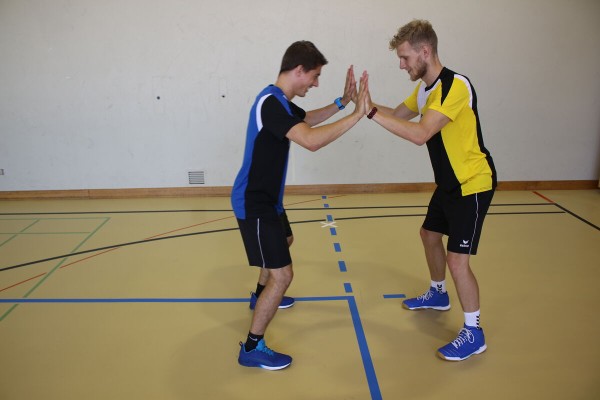
Two participants stand opposite each other in a slight straddle position and touch each other with their palms (or a small distance between the palms). The participants try to unbalance their opponent by pushing or dodging quickly and forcefully, without moving their feet. Whoever moves their feet loses.
No material required
Post run
Basic training
Group work
A continuous/loop run is carried out, in which strengthening exercises are integrated after a certain running distance (e.g. push-ups, trunk bends, pull-ups, jump forms, support legs, etc.). The strengthening exercises to be completed are specified either by means of posters or by a leader.
Course: circuit
Intensity level: 3 (medium)
Hmax: 80-90%
Rule of speech: speak in full sentences
Caution:
Course clearly visible from post to post (e.g. on sight, with signs).e.g. on sight, with signs or maps).
Variant:
Use existing course inside or outside the weapons range (defined course including permanently installed control posters).
x control posters (to be displayed in advance if not permanently installed)
1 exercise sequence (for sports leaders)
FTA evaluation (group formation)
Per participant:
1 heart rate monitor
Per group:
1 control overview